16 Fly Repelling Plants for a Peaceful Outdoor Space
Wouldn’t it be great to be able to relax in your garden, a cool breeze rustling the leaves, the scent of fresh blooms wafting through the air, and not a single fly in sight. It sounds idyllic, doesn’t it?
While at certain times it may seem like a distant dream, achieving a fly-free garden is simpler than you think. By incorporating specific plants known for their pest-repelling properties, you can create a tranquil outdoor space free from annoying insects. Here are sixteen fly-repelling plants that can help you reclaim your garden’s serenity.
Fly Repelling Plants
1. Nasturtiums
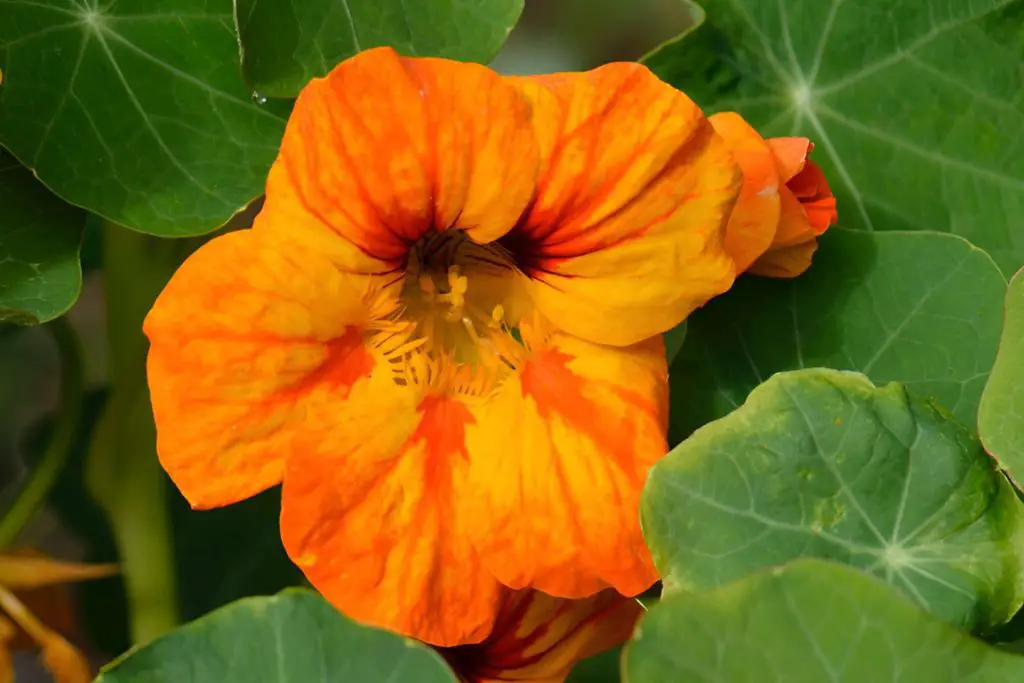
Known for their vibrant and spicy edible blooms, nasturtiums are not just a feast for the eyes. The high concentration of myristicin and limonene in their leaves and flowers makes them a natural fly repellent. Plant nasturtiums around the borders of your garden or in containers on your patio to keep flies at bay while adding a pop of color.
Nasturtiums Identification
- Appearance: Nasturtiums have round, shield-shaped leaves with a slightly waxy surface and vibrant, funnel-shaped flowers in shades of yellow, orange, and red.
- Height: They can grow up to 30 cm (12 inches) tall, with trailing varieties spreading much further.
- Flowers: The flowers are about 5 cm (2 inches) in diameter, blooming from summer to fall, with spur-like structures at the back.
2. Marigolds
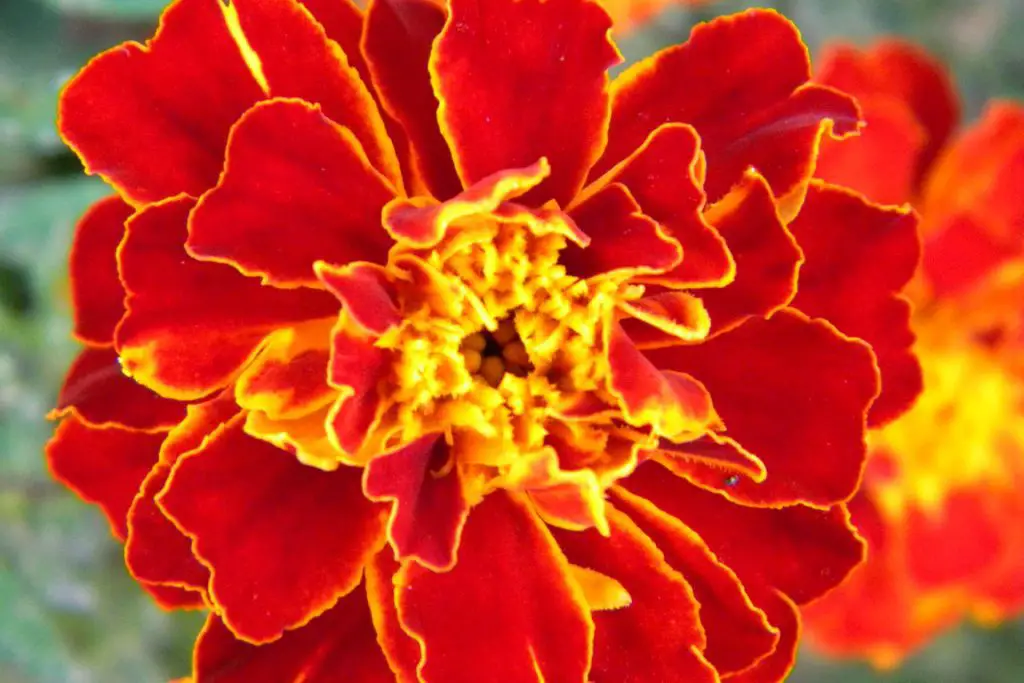
Marigolds are a versatile addition to any garden. Their pungent scent is scientifically proven to deter various pests, including whiteflies. Whether planted in your garden beds or potted indoors, marigolds can help maintain a pest-free environment. Plus, their bright blooms add cheerful tones to your outdoor decor.
Marigolds Identification
- Appearance: Marigolds have pinnate green leaves and large, ruffled flowers in bright shades of yellow, orange, and red.
- Height: They can grow up to 90 cm (36 inches) tall.
- Flowers: The flower heads are about 5 cm (2 inches) in diameter, blooming from late spring until frost.
3. Lavender

The soothing aroma of lavender is a favorite for humans but a deterrent for flies. Lavender’s potent oils are highly effective at keeping flies and other pests away from your flowers and vegetables. Plant lavender along walkways, in garden borders, or in pots near your seating areas to enjoy its calming scent while repelling insects.
Lavender Identification
- Appearance: Lavender has narrow, grayish-green leaves and produces tall spikes of aromatic flowers.
- Height: It can grow up to 90 cm (36 inches) tall.
- Flowers: The small, fragrant flowers are usually purple or blue, blooming from late spring to early summer.
4. Lemon Balm
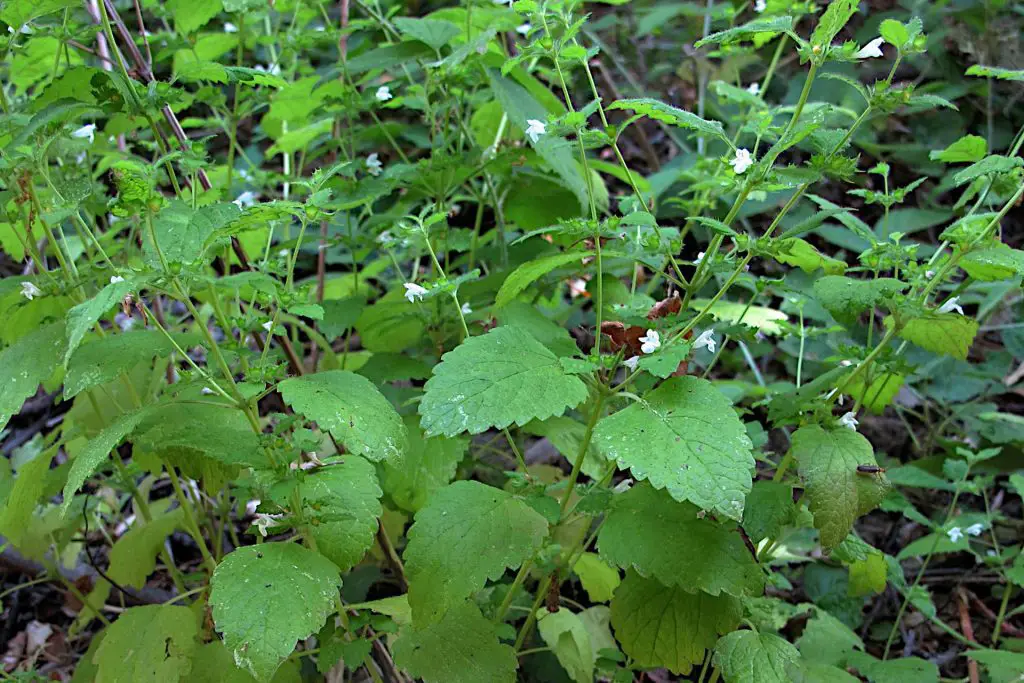
Lemon balm, with its strong lemon scent and slightly sticky texture, is unappealing to flies.This plant not only repels flies but also mosquitoes, making it an excellent addition to your garden. Use lemon balm in herbal teas or as a fragrant addition to salads while benefiting from its insect-repelling properties.
Lemon Balm Identification
- Appearance: Lemon balm has a lemon-scented, aromatic perennial plant with serrated, heart-shaped leaves and whorls of small white flowers.
- Height: It can grow up to 80 cm (30 inches) tall.
- Flowers: The pale white labial flowers are approximately 1 cm in size and grow from the leaf axils in semi-verticils. They bloom from June to September depending on the geographic location.
5. Rosemary

Rosemary is a culinary favorite that doubles as an effective fly repellent. This hardy perennial emits a woody scent that flies dislike. Plant rosemary in your garden beds or keep pots of it near your outdoor dining area to enjoy both its aromatic and pest-repelling benefits.
Rosemary Identification
- Appearance: Rosemary has needle-like, aromatic leaves that are dark green on top and silver underneath, with a woody stem.
- Height: It can grow up to 1.5 meters (5 feet) tall.
- Flowers: The small, blue to white flowers bloom in clusters along the stems, typically in spring and early summer.
6. Sage

Common sage is another aromatic herb that flies tend to avoid. Fast-growing and easy to maintain, sage can be planted in your garden or in containers. Use its leaves in your cooking or as a fragrant addition to bouquets, all while keeping flies at a distance.
Sage Identification
- Appearance: Sage has elongated, grayish-green leaves with a slightly pebbled texture and a strong, earthy aroma.
- Height: It can grow up to 70 cm (28 inches) tall.
- Flowers: The flowers are usually blue to purplish, growing in spikes and blooming from late spring to early summer.
7. Basil
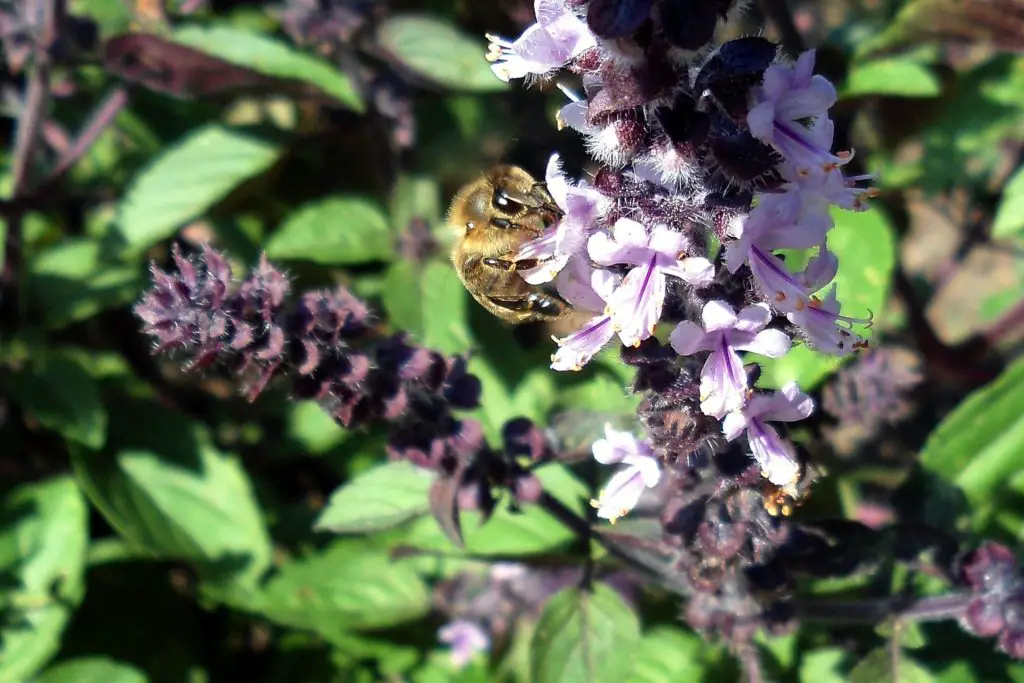
Basil is a specialist in repelling house flies and mosquitoes. Keep pots of basil by your doorways, on windowsills, or in your garden to deter flies and attract beneficial insects such as bees. As a bonus, you’ll have fresh basil leaves on hand for your culinary creations.
Basil Identification
- Appearance: Basil has bright green, smooth, and oval-shaped leaves with a slightly sweet aroma.
- Height: It can grow up to 60 cm (24 inches) tall.
- Flowers: The small, white to pinkish flowers grow in spikes and bloom from mid-summer to early fall.
8. Lemongrass
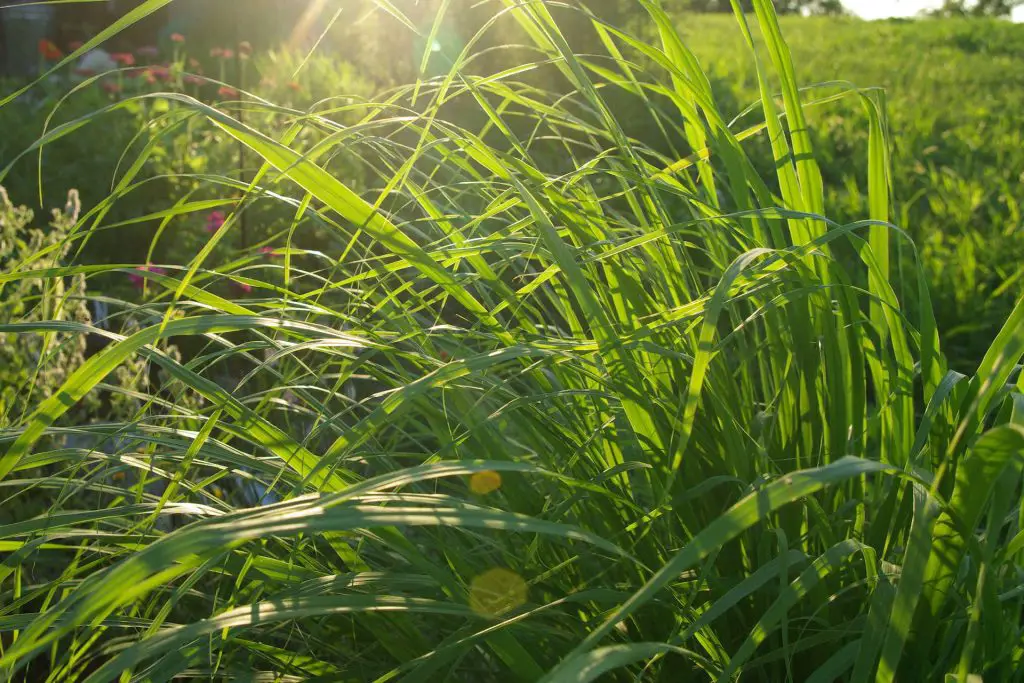
Lemongrass contains natural citronella oil, which is well-known for its mosquito-repelling properties. Plant lemongrass in your garden or in large pots around your patio to enjoy its fresh scent and keep both flies and mosquitoes away.
Lemongrass Identification
- Appearance: Lemongrass has tall, slender, and arching leaves with a strong lemon scent and a slightly rough texture.
- Height: It can grow up to 1.5 meters (5 feet) tall.
- Flowers: Lemongrass rarely flowers, but when it does, it produces small, whitish-green to brown flowers in large clusters.
9. Floss Flowers
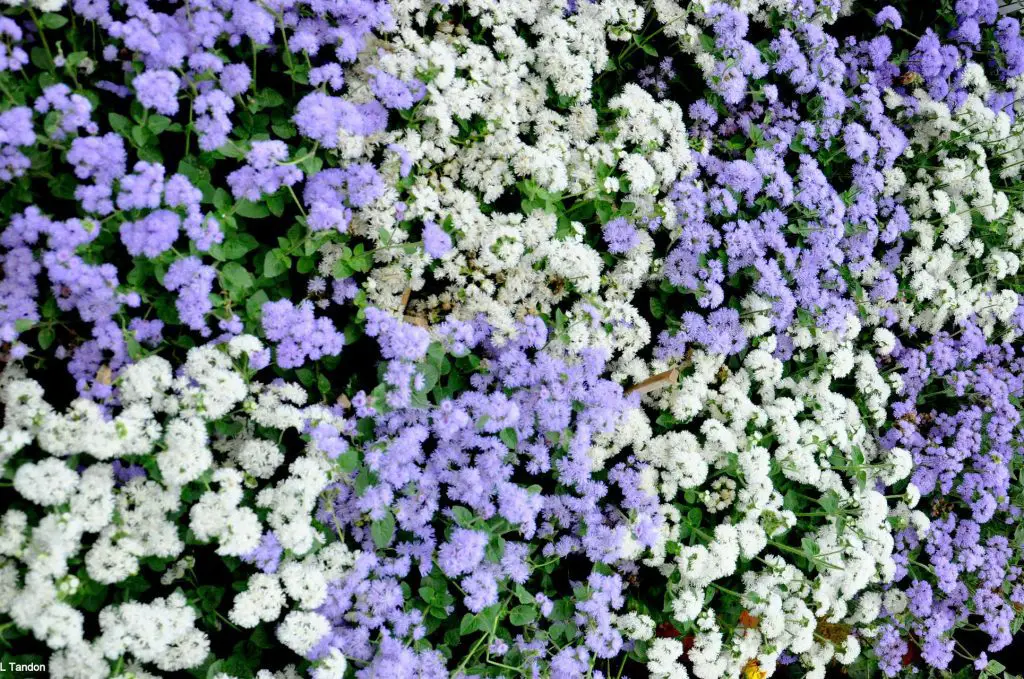
Floss flowers, with their delicate blue blooms, contain a chemical similar to that found in sweetgrass, which repels bugs and mosquitoes. These flowers are ideal for flower beds and rock gardens, adding both beauty and functionality to your outdoor space.
Floss Flowers Identification
- Appearance: Floss flowers have fuzzy, rounded clusters of small, fluffy flowers, typically in shades of blue, purple, pink, or white.
- Height: They can grow up to 60 cm (24 inches) tall.
- Flowers: The flowers are about 1 cm in diameter, blooming from late spring to fall.
10. Mint
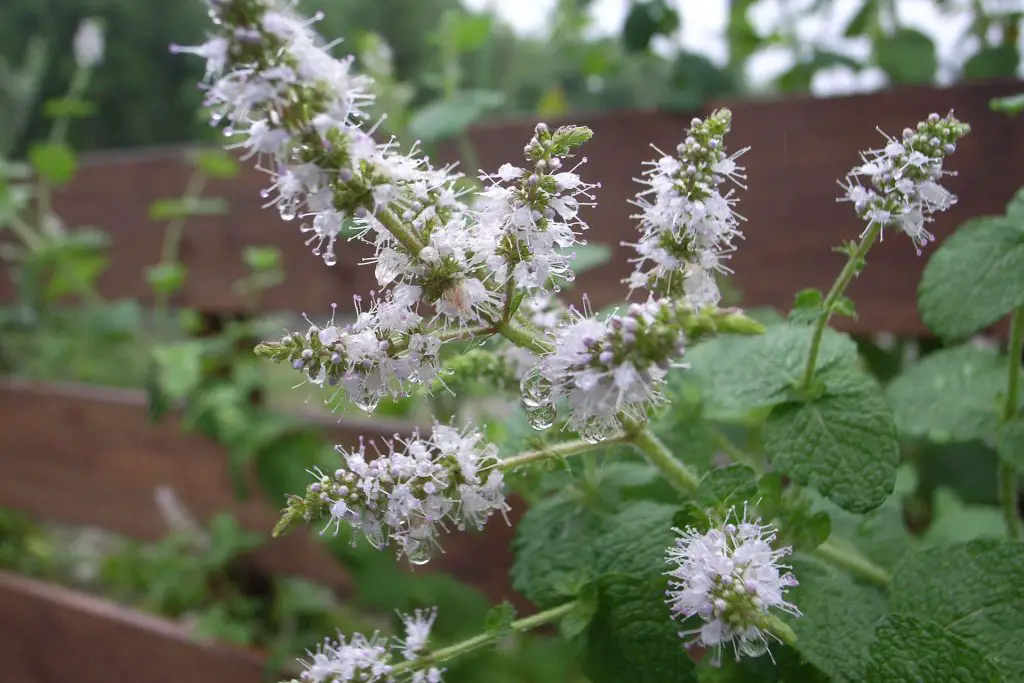
Mint is another powerful insect repellent. Its strong scent deters flies and mosquitoes. Plant mint in pots to prevent it from spreading uncontrollably and place them around your garden or outdoor seating areas. Enjoy its fresh leaves in teas and salads while keeping pests away.
Mint Identification
- Appearance: Mint has aromatic, bright green, oval-shaped leaves with serrated edges and a slightly fuzzy texture.
- Height: It can grow up to 60 cm (24 inches) tall.
- Flowers: The small, tubular flowers can be white, pink, or light purple and grow in dense clusters. They bloom from June to September.
11. Peppermint
Peppermint is a fresh and aromatic herb commonly used in cooking and herbal remedies. Its strong menthol scent is highly effective at repelling flies, making it a practical addition to your garden or patio. Plant peppermint in pots or garden beds to enjoy its refreshing fragrance while keeping flies away.
Peppermint Identification
- Appearance: Peppermint has bright green, lance-shaped leaves with serrated edges and a smooth surface. The plant also produces small, purple flowers.
- Height: Typically grows to about 30-90 cm (12-35 inches) tall.
- Flowers: The flowers are small and purple, arranged in spikes, and bloom from summer to early autumn.
12. Citronella
Citronella, often associated with mosquito repellent, is also effective against flies. The plant’s strong citrus aroma deters insects, making it a valuable addition to any outdoor space. Grow citronella in containers or garden beds to enjoy a fly-free environment.
Citronella Identification
- Appearance: Citronella has long, narrow, bright green leaves that resemble those of lemongrass. The plant has a tufted appearance.
- Height: Can reach up to 1.5 meters (5 feet) tall.
- Flowers: Produces small, inconspicuous flowers, typically in shades of green or brown.
13. Eucalyptus
Eucalyptus is known for its medicinal properties and its ability to repel flies and other pests. The plant’s aromatic leaves release a potent scent that insects find unpleasant. Plant eucalyptus in large containers or garden beds to benefit from its fly-repellent properties.
Eucalyptus Identification
- Appearance: Eucalyptus has long, slender, blue-green leaves with a leathery texture and a silvery sheen. The bark is often peeling and can be smooth or rough.
- Height: Depending on the variety, eucalyptus can grow from 2 meters (6.5 feet) to over 20 meters (65 feet) tall.
- Flowers: The flowers are small, fluffy, and typically white or cream-colored, blooming in clusters.
14. Chrysanthemums
Chrysanthemums are well-known for their beautiful blooms and their natural insecticidal properties. The pyrethrum compounds in their flowers act as a powerful fly repellent. Plant chrysanthemums around your garden or in pots to enjoy their vibrant colors while keeping flies away.
Chrysanthemums Identification
- Appearance: Chrysanthemums have deeply lobed, dark green leaves and large, daisy-like flowers in a wide range of colors including white, yellow, pink, red, and purple.
- Height: Typically grow to about 30-90 cm (12-35 inches) tall.
- Flowers: The flowers are large, often measuring up to 10 cm (4 inches) in diameter, and bloom from late summer to autumn.
15. Bay Tree (Leaves)
Bay trees are not only valued for their culinary uses but also for their fly-repellent properties. The leaves contain essential oils that emit a strong aroma, deterring flies. Plant a bay tree in your garden or keep it in a pot near seating areas to reduce fly presence.
Bay Tree Identification
- Appearance: Bay trees have dark green, glossy, and leathery leaves with a distinct aroma. The tree has a compact, rounded shape.
- Height: Can grow up to 12 meters (40 feet) tall, but is often kept pruned to about 1.5-2 meters (5-6.5 feet) in containers.
- Flowers: Small, yellow-green flowers appear in clusters in the spring, followed by dark purple berries.
16. Geraniums
Geraniums are popular ornamental plants with a bonus benefit: they repel flies. The citronella variety, in particular, emits a lemony scent that insects dislike. Plant geraniums in window boxes, containers, or garden beds to add beauty and deter flies.
Geraniums Identification
- Appearance: Geraniums have rounded, slightly lobed leaves with a hairy texture and vibrant flowers in shades of pink, red, white, and purple.
- Height: Typically grow to about 30-60 cm (12-24 inches) tall.
- Flowers: The flowers are small, about 2-5 cm (1-2 inches) in diameter, and bloom throughout the growing season.
How Do Fly-Repellent Plants Work to Deter Flies
You may ask why do some plants repel flies and others don’t? Well, fly-repellent plants work by emitting natural oils and fragrances that flies find unappealing or even repulsive. These plants contain various chemical compounds that are released into the air, which flies detect and avoid. Here are some key ways these plants deter flies:
- Strong Aromas: Plants like lavender, rosemary, and mint release strong, pungent aromas that flies dislike. These scents can be overwhelming for flies, causing them to avoid the area.
- Chemical Compounds: Certain plants, such as lemongrass, contain citronella oil, which is known for its insect-repelling properties. Other plants like lavender and basil contain linalool and geraniol, respectively, which are also effective against flies.
- Physical Barriers: Some plants, like nasturtiums, have a strong, spicy flavor that flies find unpleasant. This can help deter flies from approaching the plant.
- Visual Cues: Some plants, like the Venus flytrap, have visual cues that attract flies but then trap them. This can be an effective way to eliminate flies without using chemicals.
- Companion Planting: Some plants, like sage and marigolds, can be used as companion plants to repel flies. By planting them near other plants, they can help deter flies from those areas.
These natural effects from fly repelling plants can be used alone or in combination with other fly control techniques for a comprehensive approach to managing fly populations.
The Versatility of Planting Pots and Containers

It is not just what you plant that can alleviate a fly problem but how you plant can make a huge difference to the effectiveness of the strategy. Planting pots and containers offer an exceptional way to manage your garden space effectively, especially when dealing with fly-repelling plants. One of the most significant advantages is the ability to move these plants around as needed. If a particular area of your garden becomes a hotspot for flies, you can simply relocate the pots to create a more favorable environment.
Flexibility in placement means you can position fly-repellent plants exactly where they are needed most. For example, placing potted basil or lavender near outdoor seating areas can significantly reduce the presence of flies, making your relaxation time more enjoyable. Additionally, pots can be moved to follow the sun, ensuring that your plants get the optimal amount of light throughout the day.
Changing weather conditions often affect garden plants, but using pots and containers mitigates this issue. In case of extreme weather, you can easily bring the plants indoors or move them to a sheltered location. This not only protects the plants but also maintains their effectiveness in repelling flies.
Furthermore, using pots and containers allows for a mix of different plants in a single area without the risk of them overpowering each other. Combining rosemary, marigolds, and lemon balm in a cluster of pots can create a powerful fly-repelling zone that enhances both the functionality and aesthetics of your garden.
Incorporating pots and containers into your gardening strategy offers convenience and adaptability. Whether it’s maximizing sunlight, adjusting to weather changes, or strategically placing plants to ward off flies, containers provide an invaluable tool for maintaining a peaceful and fly-free outdoor space.
Using Fly-Repellent Plants with Other Methods
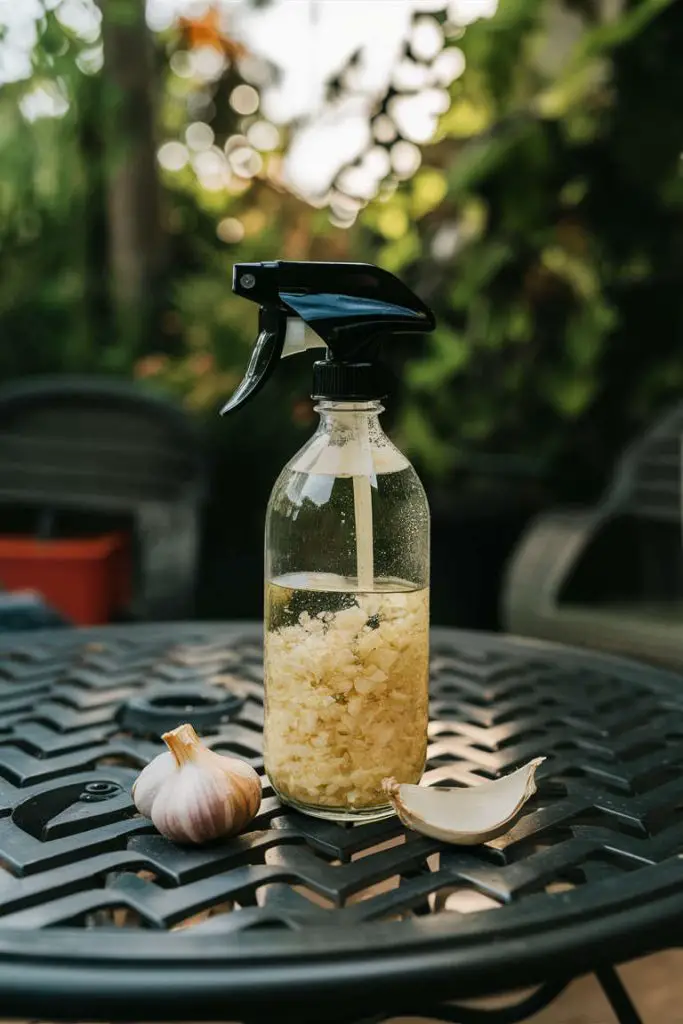
Combining fly-repellent plants with other methods creates a robust defense against pesky insects, ensuring a more enjoyable outdoor experience. Integrating natural plant repellents with complementary strategies enhances their effectiveness and provides a comprehensive solution to fly problems.
One effective method involves using essential oils alongside your fly-repellent plants. Essential oils, such as lavender, rosemary, and citronella, can be applied to outdoor furniture or diffused in the air. The combined scents of the oils and the plants create a powerful barrier that flies find unappealing.
Maintaining cleanliness in outdoor areas is another crucial strategy. Regularly removing food scraps, standing water, and other potential attractants reduces the likelihood of flies invading your space. Pairing this practice with strategically placed potted fly-repellent plants adds an extra layer of protection.
Screens and netting offer physical barriers that work well with the natural deterrents provided by plants. Installing screens around outdoor seating areas or using netting over food and drinks prevents flies from accessing these spots. When combined with the presence of plants like basil or marigolds, the effectiveness of these barriers increases significantly.
Additionally, using fans in outdoor spaces disrupts the flight patterns of flies, making it harder for them to settle. The breeze from fans complements the natural repellent properties of plants such as lemon balm and mint, creating an inhospitable environment for flies.
A combination approach not only maximizes the strengths of each method but also reduces reliance on chemical insecticides. This holistic strategy promotes a healthier environment for both humans and beneficial garden creatures. Using natural solutions ensures that your garden remains a pleasant, fly-free haven.
Integrating multiple fly-repellent techniques, including the use of specific plants, provides a multi-faceted defense against flies. This comprehensive approach guarantees a more effective and sustainable solution, allowing you to fully enjoy your outdoor spaces without the nuisance of unwanted insects.
Final Thoughts: Creating a Fly-Free Environment
Creating a fly-free outdoor space involves more than just planting a few strategic flowers. Combining the natural power of fly-repellent plants with other effective methods can transform your garden into a serene haven. The flexibility of using pots and containers allows for easy relocation of plants to optimal spots, maximizing their pest-repelling abilities.
Adding essential oils, maintaining cleanliness, installing screens, and utilizing fans complement the natural defenses provided by plants like lavender, basil, and marigolds. This multifaceted approach not only enhances the effectiveness of each individual method but also reduces the need for chemical interventions, promoting a healthier and more eco-friendly environment.
Ultimately, embracing a combination of strategies ensures a comprehensive and lasting solution to keep flies at bay. Your garden can become a peaceful retreat where you can fully relax and enjoy nature without the intrusion of bothersome insects. With these thoughtful techniques, your outdoor space will flourish as a true fly-free Environment
